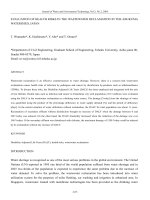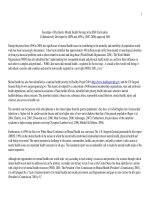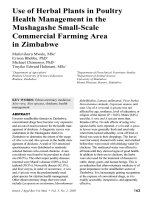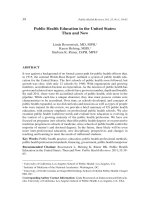Enhancing Health Security in APEC -International campaign program to control antimicrobial resistance in the Asia-Pacific
Bạn đang xem bản rút gọn của tài liệu. Xem và tải ngay bản đầy đủ của tài liệu tại đây (1.37 MB, 11 trang )
Enhancing Health Security in APEC International campaign program to control
antimicrobial resistance in the Asia-Pacific
Samsung Medical Center
Sungkyunkwan University, Seoul, Korea ;
Asia Pacific Foundation for Infectious Diseases (APFID)
Background of the project
Global crisis of antimicrobial resistance
1
Background of the project
Global crisis of antimicrobial resistance
WHO Director-General, Dr. Margaret Chan
“If current trends continue unabated, the future is easy to predict …
This will be a post-antibiotic era. A post-antibiotic era means, in
effect, an end to modern medicine as we know it.”
- Conference on combating antimicrobial resistance : time for action
Copenhagen, Denmark March 14, 2012
Background of the project
Global crisis of antimicrobial resistance
World Economic Forum highlights
antimicrobial resistance as a major
global risk in their Global Risks 2013
report published in January 2013.
Annual cost of AMR :
USA : $ 21 ~ 34 billion
EU : € 1.5 billion
Losses to GDP : 0.4 ~ 1.6 %
World Economic Forum. Global Risks 2013. 8 th Ed.
2
Background of the project
Global crisis of antimicrobial resistance
Japan : ARB found in
Tokyo’s urban watershed
EU : 25,000 deaths /yr
USA : 99,000 deaths /yr
from HAI
China : 80,000 deaths /yr
Taiwan : PDR GNB
Pakistan : 71% newborn
infections are from ARB
India : AMR rate x 3
Brazil : ARB rate > 60 %
Thailand : > 30,000 deaths /yr
Tanzania : death rate of
ARB x2 of malaria
World Economic Forum. Global Risks 2013. 8 th Ed.
Background of the project
Current situation of resistance in the AP region
Asian countries are the epicenter of antimicrobial resistance (AMR)
- Highest prevalence rates of AMR in major bacterial pathogens
- Two- or three-times higher than those in the western part of the world
Main reasons for AMR in Asia
- Widespread abuse and misuse of antibiotics
- Spread of resistant clones
- Lack of awareness, weak and unorganized policies and regulations
Comprehensive strategies for control and prevention of AMR are
urgently required in the AP region
3
Background of the project
Antimicrobial resistance in Asia
High prevalence of macrolide resistance in pneumococci in Asia
<30%
<30%
30-50%
30-50%
>70%
<30%
50-70%
<30%
Kim SH, ANSORP. Antimicrob Agents Chemother. 2012;56:1418-1426; Reinert RR,et al. Antimicrob Agents Chemother. 2005;49:2903-2913;
Sahm DF, et al. Otolaryn Head Neck Surg. 2007;136:385-389;Jacobs MR, et al. Antimicrob Agents Chemother. 2010;54:27162-2719;
Harimaya A, et al. J Infect Chemother. 2007;13:219-223; Liebowitz LD, et al. J Clin Pathol. 2003;56:344-347.
Background of the project
Multiple factors for a bad situation
Social factors
Microbial factors
Poverty & inadequate resources
Natural calamities
Human population growth
Epidemic clones
Specific serotypes
Specific resistance genes
Antibiotic factors
Antibiotic abuse/misuse in patients
Agricultural use of antimicrobials
Counterfeit drugs
Policy & regulation
Poor healthcare infrastructure
Lack of international collaboration
4
APEC project to combat AMR in Asia
Asia’s effort since 2010
Collaboration with APEC to control and prevent AMR in Asia
1st project
(2010-2011)
“International initiatives
to control AMR in the AP region”
2nd project
(2012-2013)
“International campaign program
to control AMR in the AP region”
3rd project
(2013)
“APEC symposium on control and
prevention of AMR”
APEC project to combat AMR in Asia
Asia’s effort since 2010
5
APEC project to combat AMR in Asia
1st APEC project (2010-2011)
Public’s knowledge and attitudes to antibiotic use in Asia (2011)*
Adequate
Not adequate
Korea
Japan
China
Chinese Taipei
Hong Kong China
Viet Nam
Philippines
India
Sri Lanka
Malaysia
Thailand
Indonesia
Singapore
* Based on questionnaire results from ID experts in Asian countries
APEC project to combat AMR in Asia
1st APEC project (2010-2011)
Surveillance
of AMR and
antibiotic use
Policy &
regulation
Increased
Increased
awareness
awareness
Control of
antimicrobial
resistance
Appropriate
use of
effective
antibiotics
Vaccination
Infection
control
6
APEC project to combat AMR in Asia
Current APEC project (2012-2013) : “Campaign 4”
The first and the most urgent plan is to increase the awareness of AMR
and to promote the appropriate use of effective antibiotics that can
prevent the emergence of AMR in the region
Educational and campaign programs should be implemented to
increase the awareness in the region
There have been no effective campaign programs to control and
prevent AMR in the Asian region
International collaboration for campaign program is very important
because resistant pathogens can spread across the borders
APEC project to combat AMR in Asia
Current APEC project (2012-2013) : “Campaign 4”
Very few national campaigns
in some Asian countries
7
APEC project to combat AMR in Asia
Campaign 4 : goal and obejectives
Long-term goal of the project
To control and prevent AMR in the AP region based on strategic action plans
including increased awareness of AMR, appropriate antibiotic use, infection
control, vaccination, and relevant policies and regulations
Main objectives of the project
To develop campaign strategies to increase the awareness of AMR and to
promote the appropriate use of antibiotics in the AP region
To develop and provide platform contents and materials of campaign
program for APEC economies
To set out to implement the international campaign program in APEC
economies
APEC project to combat AMR in Asia
Campaign 4
8
APEC project to combat AMR in Asia
Host organization of Campaign 4
APFID* CARES the future of health in Asia since 1996
ISAAR
Conference
International Symposium on Antimicrobial Agents and Resistance
I CARE
Awareness
Initiatives to Control Antimicrobial REsistance
ABB
Resource
Asian Bacterial Bank
IDRI
Experiment
Surveillance
Infectious Disease Research Institute
ANSORP
Asian Network for Surveillance of Resistant Pathogens
APEC project to combat AMR in Asia
“I CARE” strategies in Asia
Increased
awareness
Appropriate
antibiotic use
Infection
control
Vaccination
Surveillance of AMR
Policies and regulations
9
APEC project to combat AMR in Asia
Collaboration for Campaign 4
Professional society &
Government in Asian economies
Expected impact of the project
International collaboration for control of AMR
10
Increased awareness of AMR / Appropriate use of antibiotics
Strategic action plan in Asia : campaign 4
Campaign 4 for general public
Main Messages
No antibiotics without prescription
No left-over antibiotics
No antibiotics for common cold
No antibiotics with inappropriate dose &
duration
Increased awareness of AMR / Appropriate use of antibiotics
Strategic action plan in Asia : campaign 4
Major Targets
General public and patients
Healthcare professionals
Pharmaceutical industry
Policy-makers and planners
11









